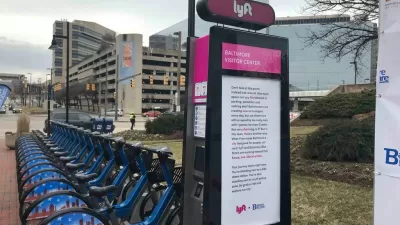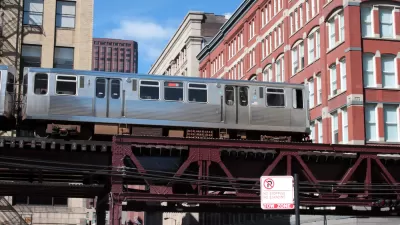The cost of 'deadheading'–the time ride-hailing drivers spend looking for fares–offsets any environmental benefits created by the industry, despite early claims that the apps would reduce congestion and air pollution.

Despite early promises to reduce personal car trips and ease urban congestion, data shows that ridesharing companies like Uber and Lyft have done the opposite. "Now a new study puts a price on the external costs that come with switching from a personal vehicle to one from a transportation network company (or TNC): about 35 cents per trip on average. And it finds that even a fully electrified fleet of ride-hailing cars may not fully mitigate the extra toll they exact on society compared to driving yourself," writes Laura Bliss.
The authors of the study "simulated replacing 100,000 private passenger vehicle trips with TNC trips in six U.S. cities, using publicly available ride-hailing data from New York City, Austin, Chicago and the state of California." The simulation showed that, while TNCs "brought a 50% to 60% decrease in local air pollution costs" by keeping cars in use more of the time and hence reducing the pollution caused when fuel-combustion engines start cold, "that benefit was undone by the negative impacts of deadheading, or the time in between trips when drivers are traveling passenger-free to their next pickup." According to a 2019 report from the ridesharing companies themselves, "deadheading accounted for roughly 40% of all TNC miles across six U.S. cities." This added traffic "increased fuel consumption and its associated greenhouse gas emissions by roughly 20%, and drove up social costs linked to congestion, crashes and noise by 60%."
When analyzed against public transportation, "[t]he costs to society tripled," Bliss writes. "More surprising is that when Michalek and his collaborators simulated a fleet of 100% zero-emission TNC vehicles — charged by a zero-carbon grid — the external costs of ride-hailing only dropped by 16% to 17%." This means that "even a fully electrified ride-hailing industry — the likes of which Uber and Lyft have both promised by 2030 — would not be enough to make up for the congestion and deaths created by the added TNC miles." This is only mitigated when rides are pooled, though pooled rides are still more harmful than taking public transit.
One way cities can discourage single TNC rides is by pricing them accordingly, encouraging riders to pool rides while maintaining the positive effects of ridesharing apps, such as "providing late-night transportation services and reducing drunk driving."
FULL STORY: That Uber or Lyft Trip May Be Worse for the Planet Than Driving Yourself

Trump Administration Could Effectively End Housing Voucher Program
Federal officials are eyeing major cuts to the Section 8 program that helps millions of low-income households pay rent.

Planetizen Federal Action Tracker
A weekly monitor of how Trump’s orders and actions are impacting planners and planning in America.

Ken Jennings Launches Transit Web Series
The Jeopardy champ wants you to ride public transit.

Washington Legislature Passes Rent Increase Cap
A bill that caps rent increases at 7 percent plus inflation is headed to the governor’s desk.

From Planning to Action: How LA County Is Rethinking Climate Resilience
Chief Sustainability Officer Rita Kampalath outlines the County’s shift from planning to implementation in its climate resilience efforts, emphasizing cross-departmental coordination, updated recovery strategies, and the need for flexible funding.

New Mexico Aging Department Commits to Helping Seniors Age ‘In Place’ and ‘Autonomously’ in New Draft Plan
As New Mexico’s population of seniors continues to grow, the state’s aging department is proposing expanded initiatives to help seniors maintain their autonomy while also supporting family caregivers.
Urban Design for Planners 1: Software Tools
This six-course series explores essential urban design concepts using open source software and equips planners with the tools they need to participate fully in the urban design process.
Planning for Universal Design
Learn the tools for implementing Universal Design in planning regulations.
Heyer Gruel & Associates PA
Ada County Highway District
Institute for Housing and Urban Development Studies (IHS)
City of Grandview
Harvard GSD Executive Education
Toledo-Lucas County Plan Commissions
Salt Lake City
NYU Wagner Graduate School of Public Service




























